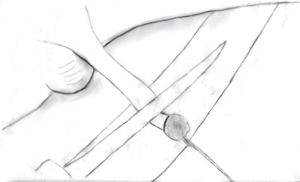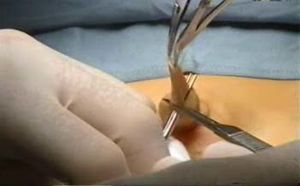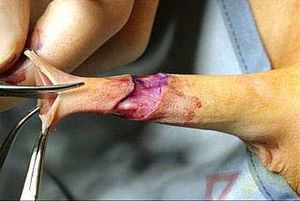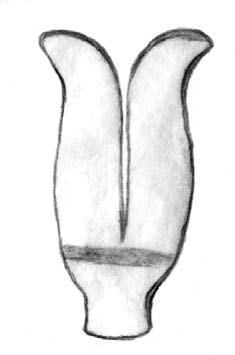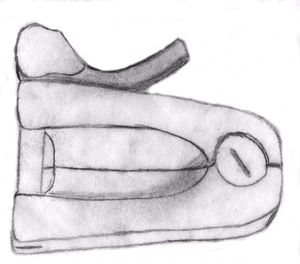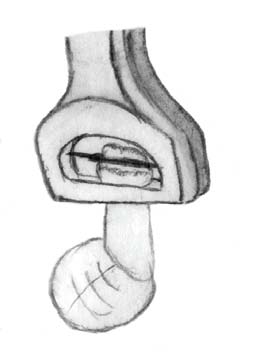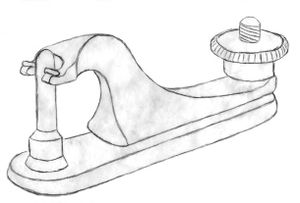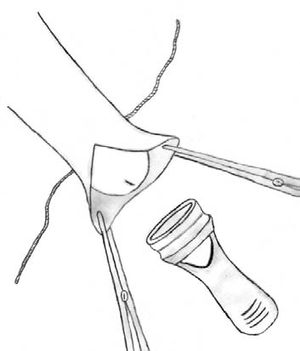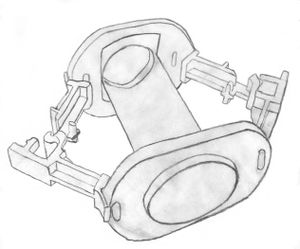Circumcision methods
Circumcision is performed in many ways which vary by culture, the person performing it, and the age of the subject. It may be performed by a specialized ritual circumciser in a non-medical setting, or a medical practitioner at a hospital or clinic. In some cultures, only the protruding end of the foreskin is cut off, and in others, the entire foreskin which covers the glans is removed. Some circumcisers take more skin than others, resulting in a "loose" or "tight" circumcision.
Generally, the foreskin is pulled forward and enough of it is removed to permanently expose the glans of the penis. Sometimes a protective device is used to avoid hurting the glans, and sometimes the circumciser simply performs the procedure freehand. In adults, stitches are used to stop the bleeding and help close the wound. In infants, circumcisers often use a clamp that crushes the foreskin and seals the wound, eliminating the need for stitches.
Contents
Circumcision in detail: Styles, techniques and instruments
During circumcision, the foreskin of the penis is partly or completely removed. The exact amount and type of skin removed depends on the style and technique used, and therefore also on the tools being used.
Common styles
High & Tight
This style is the most common in the USA. In this style, the outer foreskin, parts of the inner foreskin and parts of the shaft skin are removed.
The remaining part of the inner foreskin is folded back and sewed to the shaft skin. The scar is located closer to the body, hence the term "high".
The inner foreskin, which originally faced inwards lying on the glans, now faces outward; this causes the differently coloured section between glans and shaft skin which is characteristic for this style.
Of all styles, the tight ones remove the most skin. They already limit the mobility of the penile skin to a great extent when the penis is flaccid, and during an erection the skin is fully stretched and immobile. An insufficient amount of reserve skin can hamper a complete erection and lead to painful tension. Also, a skewed penis can occur due to an uneven distribution of the remaining skin, often caused by an inaccurately placed cut or a uneven growth during wound healing. Due to the extensive shortening of the inner foreskin, this style also means the loss of large amounts of sensitive tissue.
Low & Tight
In this style, both the inner and outer foreskin are completely removed. The shaft skin is sewed just below the rim of the glans. The scar is located close the glans, hence the term "low".
This style is the most radical, as it removes the entire sensitive tissue of the foreskin. As in the high & tight style, large amounts of skin are removed. In a flaccid state, the skin is barely movable, and in an erect state it is totally immobile.
An insufficient amount of reserve skin can hamper an erection and lead to painful tension and a skewed penis in this style as well.
High & Loose
The outer foreskin is completely removed, as well as parts of the shaft skin. The inner foreskin is folded back and sewed to the shaft skin. The scar is located towards the body, hence the term "high". Unlike the high & tight style, the inner foreskin is less reduced, and lies in folds behind the glans.
There is enough remaining reserve skin to ensure a complete and unhindered erection. Of all variants, this one removes the smallest amount of sensitive tissue.
Low & Loose
The inner foreskin is removed, the outer foreskin is sewed on below the glans. The scar is therefore located close to the glans, hence the term "low". The outer foreskin lies in folds behind the glans. Enough skin is left in place to ensure a complete and unhindered erection.
Since, in contrast to the high & loose style, the inner instead of the outer foreskin is removed, this style results in the loss of almost all of the sensitive tissue.
Techniques and instruments
Over time, a vast variety of methods has been developed to remove the foreskin. A multitude of clamps and tools is available to ease the work of the circumciser, to improve the chance for visually symmetrical results and to prevent injuries to the glans from inexpert cuts. I will introduce some of the most widely spread variants.
Restraint
When an infant boy is to be circumcised, it is the usual practice to immobilize the infant for the painful surgery by securely tying his limbs to a molded plastic board, called a Circumstraint, specially made for that purpose. The infant thus is preventing from fighting or fleeing, which is the trauma-producing situation of inescapable shock, described as a "physical condition in which the organism cannot do anything to affect the inevitable."[1]
Freehand-techniques
The oldest method of removing the foreskin uses just a few instruments. In the simplest case, the foreskin is pulled out with a cord, a knife is placed directly above the glans, and the skin finally cut with a hit on the blunt edge of the knife. No stitches are placed and the skin is left to grow together naturally.
In modern operating theatres the foreskin is first grasped with forceps, pulled out and clamped above the glans for a while to reduce bleeding. Next, the skin is cut along the forceps with a scalpel. Following that, the remaining skin is manually trimmed according to the desired style and finally sutured.
Completely freehand techniques are also common. The penile skin is first cut in two places along the circumference, in the area of the shaft skin and foreskin. After that the skin area between the cuts is removed and the remaining skin sutured.
Also among the freehand techniques are the shield variants.
In ritual Jewish circumcision the foreskin in inserted into the slit of the shield (left) and then cut on the upper side of the shield.
The Mogen-Clamp works in a similar way (middle), with the difference that it is locked shut after the foreskin is inserted, thus clamping it. After a few minutes the foreskin is cut in the same fashion as with the simple shield. The clamping is meant to reduce or prevent bleeding from the wound.
The Sheldon-Clamp (right) works in a similar way. The inner clamp grasps the tip of the foreskin, pulling it into the outer clamp which is closed. The outer clamp then grips the skin. After a few minutes of pressure, the foreskin is cut between the two clamps.
The use of a shield, rather than forceps, is meant to provide a better protection of the glans from cutting injuries. However, if used improperly both the Mogen and the Sheldon clamp are subject to the risk of the tip of the glans being accidentally clamped and being cut into or severed.
Complex clamps
One of the most widely used clamps in the USA is the Gomco clamp. First, a cut is placed into the foreskin, then the metal bell is placed over the glans. After that, the bell, together with the foreskin, is pulled through the opening in the base plate and hung into the lever. By fastening the screw the lever pulls the bell upwards, jamming the foreskin between bell and base plate. After several minutes of clamping, the skin is cut off with a scalpel along the upper side of the base plate and the clamp removed.
In the Plastibell method, the skin is first cut lengthwise, then a plastic ring is placed over the glans and the foreskin pulled over it. A tightly tied string is used to fix the foreskin to a rim in the ring, thereby strangulating it.
The tissue beyond the string is cut off and the bell's handle cracked off. The strangulated tissue dies off in the following days, and the ring falls off on its own. Since this form of circumcision means part of the process goes on without medical supervision, it may not be possible to intervene promptly in the event of swelling; also there is a risk of the ring being removed prematurely due to external influence. This may cause the healing wound to burst open, necessitating additional suturing.
The Smartclamp and a couple of similar designs are one way clamps, representing a mixture of the Gomco and Plastibell methods. The glans is inserted into the plastic tube, the foreskin pulled over it. The base plate of the outer clamping mechanism is pushed over the foreskin and cocked shut, jamming the foreskin between the bulging lower rim of the tube and the lower base plate. The foreskin is now cut off along the upper side of the base plate. The entire clamping mechanism remains on the penis, until it - like the Plastibell - falls off by itself after the clamped skin dies off in the following days.
All of these methods have in common that the foreskin has to be separated from the glans first. In case of the circumcision of a child, it is in most cases (see chart above) necessary to forcibly tear apart the balanopreputial membrane, which fuses the foreskin to the glans, either by violently retracting the foreskin or separating it by pushing a blunt instrument underneath the foreskin, both of which can result in injuries and inflammations of the glans.
References
- ↑
 van der Kolk BA (2014): The Body Keeps the Score. P. 76. ISBN 978-0-14-312774-1. Retrieved 9 August 2021.
van der Kolk BA (2014): The Body Keeps the Score. P. 76. ISBN 978-0-14-312774-1. Retrieved 9 August 2021.





